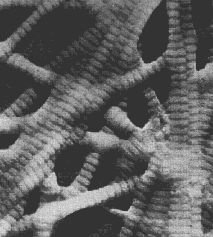| Index to this page |
29 types of collagens have been found in humans. The major ones are:
The other 25 types are probably equally important but they are much less abundant.
(glycine (Gly) - X - Y)n
where X is often proline (Pro) and Y is often hydroxyproline (proline to which an -OH group is added after synthesis of the polypeptide).The resulting molecule twists into an elongated, left-handed helix (NOT an alpha helix). When synthesized, the N- terminal and C- terminal of the polypeptide have globular domains, which keep the molecule soluble.
As they pass through the endoplasmic reticulum (ER) and Golgi apparatus,
In some collagens (e.g., Type II), the three molecules are identical (the product of a single gene). In other collagens (e.g., Type I), two polypeptides of one kind (gene product) assemble with a second, quite similar, polypeptide, that is the product of a second gene.
 When the triple helix is secreted from the cell (usually by a fibroblast), the globular ends are cleaved off. The resulting linear, insoluble molecules assemble into collagen fibers. They assemble in a staggered pattern that gives rise to the striations seen in this electron micrograph (courtesy of Dr. Jerome Gross). (Type IV collagens are an exception; they form a meshwork rather than striated fibers.)
When the triple helix is secreted from the cell (usually by a fibroblast), the globular ends are cleaved off. The resulting linear, insoluble molecules assemble into collagen fibers. They assemble in a staggered pattern that gives rise to the striations seen in this electron micrograph (courtesy of Dr. Jerome Gross). (Type IV collagens are an exception; they form a meshwork rather than striated fibers.)
Caused by a mutation in one or the other of the two genes whose products are used to make Type I collagen. Like all the inherited collagen diseases, this one is inherited as a dominant trait. The reason: even though one collagen allele is normal, the assembly of the normal gene product with the mutant product produces defective collagen fibers.
Bone marrow stem cells from patients with this disease have had their mutant gene knocked out by gene targeting [Link] and gained the ability to make good collagen and bone (when the cells were placed in immunodeficient mice). So this disease now seems to be a promising candidate for gene therapy.
Most cases involve mutations in the gene on the X chromosome for one of the chains of Type IV collagen. So it shows the typical pattern of X-linked inheritance.
Other cases are caused by two mutant autosomal genes for another of the Type IV collagen chains.
Patients usually have damage to their glomeruli, leading to blood in their urine and, often, become deaf as well.

So Goodpasture's syndrome is an example of an autoimmune disorder.
The basal lamina of the lung epithelia and the glomeruli of the kidney are especially likely to be affected. In this photo (courtesy of Dr. Frank J. Dixon), a fluorescent antibody against human IgG shows the autoantibodies coating the basement membranes of the glomeruli in a patient with Goodpasture's syndrome.
| Welcome&Next Search |